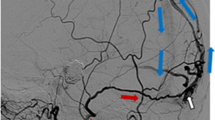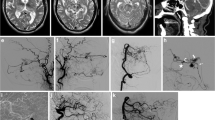Abstract
Purpose
The purpose of this study was to evaluate the effectiveness and safety as well as the clinical and angiographic results of endovascular treatment (EVT) for patients with hemorrhagic dural arteriovenous fistulas (DAVFs).
Methods
From April 2009 to November 2013, 46 consecutive patients (7 women, 39 men; mean age, 46.7 years) diagnosed with hemorrhagic intracranial DAVFs at our department were enrolled in this study. Clinical and angiographic data were reviewed and evaluated.
Results
Two fistulas were cured by transvenous approach, and all other fistulas were embolized through transarterial route. After treatment with last embolization, a residual shunt was observed in 15 patients, including near-total obliteration of the fistula in 6 patients (13.0 %) and partial obliteration of the fistula in 9 patients (19.6 %). Seven of them underwent supplementary Gamma knife surgery. Complications occurred during or after EVT in six patients. One patient died 10 days after EVT because of complications of Onyx embolus into the posterior inferior cerebellar artery. Other complications included microcatheter entrapment in one case, trigeminocardiac reflex in one, facial nerve paresis in two, and occulomotor nerve paresis in one. The facial nerve paresis in one patient markedly improved but did not completely resolve during follow-up period. The other four patients recovered well, without symptoms at clinical follow-up. Angiographic follow-up result was obtained in 35 cases, with complete obliteration in 27 of them (77.1 %). Clinical follow-up outcomes were good, with 38 patients (82.6 %) reporting modified Rankin Scale of either 0 or 1. No patient suffered recurrent intracranial hemorrhage during follow-up.
Conclusions
EVT was effective and safe in the modern management of ruptured intracranial DAVFs, with complete cure in most lesions. Clinical outcomes were good despite patients presenting with intracranial hemorrhage.



Similar content being viewed by others
References
Kwon BJ, Han MH, Kang HS, Chang KH. MR imaging findings of intracranial dural arteriovenous fistulas: relations with venous drainage patterns. AJNR Am J Neuroradiol. 2005;26:2500–7.
Piippo A, Niemelä M, van Popta J, Kangasniemi M, Rinne J, Jääskeläinen JE, Hernesniemi J. Characteristics and long-term outcome of 251 patients with dural arteriovenous fistulas in a defined population. J Neurosurg. 2013;118:923–34.
Daniels DJ, Vellimana AK, Zipfel GJ, Lanzino G. Intracranial hemorrhage from dural arteriovenous fistulas: clinical features and outcome. Neurosurg Focus. 2013;34:E15.
Gandhi D, Chen J, Pearl M, Huang J, Gemmete JJ, Kathuria S. Intracranial dural arteriovenous fistulas: classification, imaging findings, and treatment. AJNR Am J Neuroradiol. 2012;33:1007–13.
Satoh K, Satomi J, Nakajima N, Matsubara S, Nagahiro S. Cerebellar hemorrhage caused by dural arteriovenous fistula: a review of five cases. J Neurosurg. 2001;94:422–6.
Duffau H, Lopes M, Janosevic V, Sichez JP, Faillot T, Capelle L, Ismaïl M, Bitar A, Arthuis F, Fohanno D. Early rebleeding from intracranial dural arteriovenous fistulas: report of 20 cases and review of the literature. J Neurosurg. 1999;90:78–84.
Borden JA, Wu JK, Shucart WA. A proposed classification for spinal and cranial dural arteriovenous fistulous malformations and implications for treatment. J Neurosurg. 1995;82:166–79.
Cognard C, Gobin YP, Pierot L, Bailly AL, Houdart E, Casasco A, Chiras J, Merland JJ. Cerebral dural arteriovenous fistulas: clinical and angiographic correlation with a revised classification of venous drainage. Radiology. 1995;194:671–80.
Singh V, Smith WS, Lawton MT, Halbach VV, Young WL. Risk factors for hemorrhagic presentation in patients with dural arteriovenous fistulae. Neurosurgery. 2008;62:628–35.
Albuquerque FC, Ducruet AF, Crowley RW, Bristol RE, Ahmed A, McDougall CG. Transvenous to arterial Onyx embolization. J Neurointerv Surg. 2014;6:281–5.
Cognard C, Januel AC, Silva NA, Jr., Tall P. Endovascular treatment of intracranial dural arteriovenous fistulas with cortical venous drainage: new management using Onyx. AJNR Am J Neuroradiol. 2008;29:235–41.
Shi ZS, Loh Y, Duckwiler GR, Jahan R, Viñuela F. Balloon-assisted transarterial embolization of intracranial dural arteriovenous fistulas. J Neurosurg. 2009;110:921–8.
Hoh BL, Choudhri TF, Connolly ES, Jr., Solomon RA. Surgical management of high-grade intracranial dural arteriovenous fistulas: leptomeningeal venous disruption without nidus excision. Neurosurgery. 1998;42:796–805.
Guo WY, Pan DH, Wu HM, Chung WY, Shiau CY, Wang LW, Chiou HJ, Yen MY, Teng MM. Radiosurgery as a treatment alternative for dural arteriovenous fistulas of the cavernous sinus. AJNR Am J Neuroradiol. 1998;19:1081–7.
Abud TG, Nguyen A, Saint-Maurice JP, Abud DG, Bresson D, Chiumarulo L, Enesi E, Houdart E. The use of Onyx in different types of intracranial dural arteriovenous fistula. AJNR Am J Neuroradiol. 2011;32:2185–91.
Adamczyk P, Amar AP, Mack WJ, Larsen DW. Recurrence of “cured” dural arteriovenous fistulas after Onyx embolization. Neurosurg Focus. 2012;32:E12.
Puffer RC, Daniels DJ, Kallmes DF, Cloft HJ, Lanzino G. Curative Onyx embolization of tentorial dural arteriovenous fistulas. Neurosurg Focus. 2012;32:E4.
Li C, Wu Z, Yang X, Li Y, Jiang C, He H. Transarterial treatment with Onyx of Cognard type IV anterior cranial fossa dural arteriovenous fistulas. J Neurointerv Surg. 2014;6:115–20.
Agid R, Terbrugge K, Rodesch G, Andersson T, Söderman M. Management strategies for anterior cranial fossa (ethmoidal) dural arteriovenous fistulas with an emphasis on endovascular treatment. J Neurosurg. 2009;110:79–84.
Lawton MT, Sanchez-Mejia RO, Pham D, Tan J, Halbach VV. Tentorial dural arteriovenous fistulae: operative strategies and microsurgical results for six types. Neurosurgery. 2008;62:110–25.
Acknowledgments
This work was supported by the National Science Foundation of China (grant nos. 81220108007, 81171079 and 81371315) and Special Research Project for Capital Health Development (grant no. 2014-1-1071) and Special Research Project for Capital Health Development (grant no. 2014-1-1071).
Conflict of Interest
None
Author information
Authors and Affiliations
Corresponding author
Rights and permissions
About this article
Cite this article
Li, C., Yang, X., Li, Y. et al. Endovascular Treatment of Intracranial Dural Arteriovenous Fistulas Presenting with Intracranial Hemorrhage in 46 Consecutive Patients: With Emphasis on Transarterial Embolization with Onyx. Clin Neuroradiol 26, 301–308 (2016). https://doi.org/10.1007/s00062-014-0362-y
Received:
Accepted:
Published:
Issue Date:
DOI: https://doi.org/10.1007/s00062-014-0362-y




